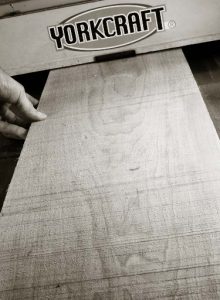We may receive a commission when you use our affiliate links. However, this does not impact our recommendations.
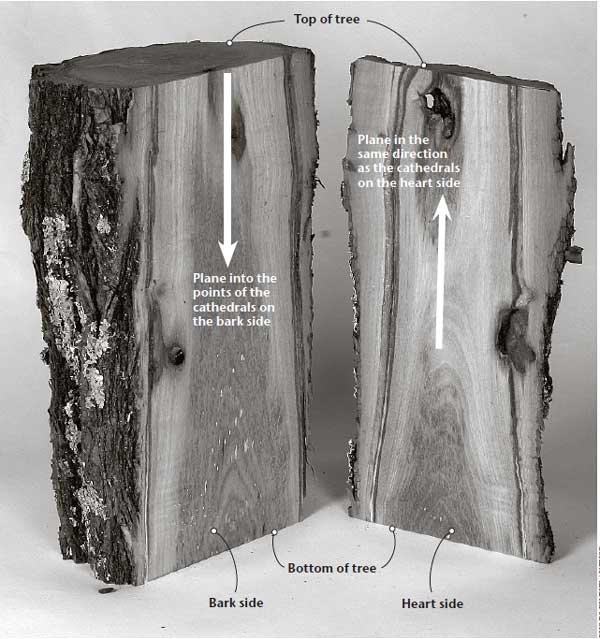
The fact that trees are slightly cone shaped can be used to your advantage when reading grain direction. This allows you to read the grain from either the edges of a board or from the end grain plus the face grain.
I often tell people that the grain direction in a board is like the fur on a cat.
Stroke the cat (or board) one way and the cat will purr, and your tool will produce a nice surface.
Stroke the cat (or board) the wrong way, however, and the cat will bite you, and your board will be as smooth as rotgut bourbon.
While that seems simple enough, the thing I sometimes neglect to mention is that boards (like cats) can behave unpredictably. And sometimes you will get bit even when you think you are doing everything right.
Wood is a little more complex than just comparing it to a bundle of soda straws or the fur of a feline, but you can understand grain direction quite well if you think a little harder about how trees grow.
Trees are Cones
Remember this: Every year, a tree grows a new layer of fibers – each layer creates one of the growth rings that are evident in many species. Also, remember that trees are bigger at the ground than they are at the top of their trunks. Each layer of fiber is therefore slightly cone shaped. And so, a mature tree is merely a series of cones stacked up on top of one another – I like to think of trees as a stack of ice cream cones.
The first time I ever saw this idea explained so simply and brilliantly was in an article by
Russell Jokela, a woodworker living in Japan. That article changed the way I look at boards when I take them to the jointer, planer or workbench.
The grain direction in any board can be read using at least two different methods. Knowing both techniques will speed your work. You will be able to tell at a glance what direction the grain likely runs in almost any board, even if that board is rough-sawn and the grain lines are almost impossible to see.
These two techniques work well with domestic hardwoods and softwoods, but they aren’t foolproof when it comes to exotic woods with interlocked grain, such as mahogany. What’s interlocked grain? Well, we’re getting ahead of ourselves now. First let’s look at the way most people are taught to read the grain.
The Edges Explain the Faces
(And Vice Versa)
The most common way to determine the grain direction on the face of a board is to examine the grain lines on the edge of that board. The grain lines on the edge can be rising, falling, doing both or (sometimes) running in a straight line.
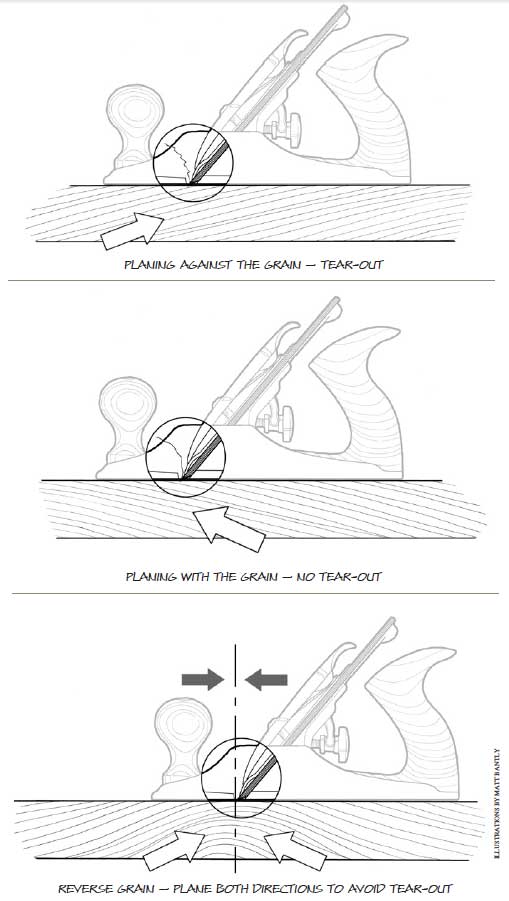 If you plane the face of that board so the tool’s cutter presses the fibers down, you will get a clean cut (like petting an animal from its head to its tail). Plane the opposite way and the cutter will act like a wedge and lift up the fibers ahead of your cutter (like rubbing an animal the wrong way). This results in tear-out.
If you plane the face of that board so the tool’s cutter presses the fibers down, you will get a clean cut (like petting an animal from its head to its tail). Plane the opposite way and the cutter will act like a wedge and lift up the fibers ahead of your cutter (like rubbing an animal the wrong way). This results in tear-out.
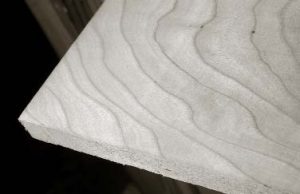
Want to know how to plane or joint this edge? Read the grain direction on its adjacent face. This is usually foolproof, unless the edge runs through the middle of a cathedral.
If the grain on the edge is straight, you sometimes can work the board’s face in either direction with good results. If the grain reverses and goes up and down on the edge, sometimes you have to work in two directions, or you have to sand or scrape out the resulting tear-out.
This whole process also works if you want to know the direction that the grain runs on the edge of a board. Simply read the grain lines on the face of a board to determine how to plane or joint the board’s edge.
Some Troubles With This Method
Reading the grain on the edges works about 75 percent of the time for me.
Sometimes the edges can offer confusing or contradictory information, especially with plain-sawn boards that have quartersawn grain along the edges. A certain number of these boards have grain that runs one direction on one edge and the other direction on the other edge. What is typical with these miscreants is that you end up with a board that’s separated into thirds: Two-thirds of the board has grain in one direction. And one-third of the grain runs the other way.
What gives? It’s called spiral grain. This is when the fibers in a tree’s growth ring don’t run straight up and down in a tree. Instead, the fibers wrap around the trunk in a spiral. When this occurs, you can have a plain-sawn board with grain running one direction up the middle of the board and along one edge, and then grain running the opposite way on the other edge.
And when the grain spirals one direction one year (clockwise) and the other direction the next year (counterclockwise), that is called interlocked grain. And that is why they invented wide belt sanders. Nothing is more difficult to work with hand tools and basic machine tools.
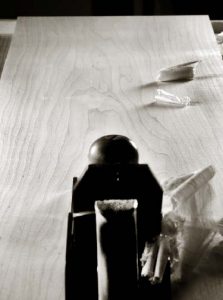
Here I’m planing the heart side of this board. The plane is following the cathedrals and the wood is behaving nicely.
Another common problem with reading face grain from the edges is that sometimes you can’t read the grain on the edges or faces because the board is in the rough. When faced with this situation in my shop, I used to just guess at the grain direction. If I was wrong, I would turn the board around and hope I had enough material thickness remaining to remove the tear-out.
And that is why I learned to read grain direction by looking at the faces and the end grain of boards.
Cathedrals, Hearts and Barking Mutts
Most boards that come into our hands are plain-sawn – that means they have quartersawn grain on their edges and flat-sawn grain in the middle. It’s this flat-sawn grain in the middle that creates the cathedrals (sometimes called peaks) on the face of a board.
If you understand that trees are cones, you can use this to your advantage.
The cathedrals on a board can point the way that the grain is running once you know if you are looking at the heart side of the board or the bark side of a board. (You can determine this easily by looking at the end grain.)
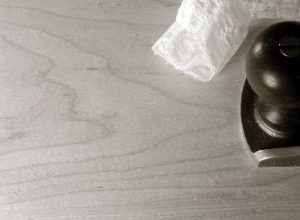
Here I’m planing the bark side of a board. Note that I’m planing into the peaks of the cathedrals. Can you hear the barking sound?
When looking at the heart side of a board, the grain direction generally goes the same direction as the cathedrals – think of the cathedrals as arrows that point the way that your handplane should travel or that the cutterhead should intersect the wood.
The way I like to remember this is: When planing the inside of the tree, plane inside the cathedrals.
When planing the bark side of a board, the grain is reversed. You plane into the tips of the cathedrals. The dumb way I remember this is that when I’m working on the bark side of a board I think of my plane as a dog (what is it with me and animals?). And the cathedrals are the barking noise coming from its mouth.
Knowing this trick won’t save you from the agony of spiral or interlocked grain, but it will help you work boards that are in the rough. Though you might not be able to see every grain line on a rough board, you can usually pick out the cathedrals.
And this will help you get the wood surfaced quickly with less guessing and less tear-out. Here’s how I proceed with a powered jointer and planer:
1. Check the board for cupping. Most boards cup on the bark side.
2. Check the face of the board for the direction the cathedrals are pointing.
3. Place the board’s bark side down on the jointer bed with the cathedrals pointing toward the machine’s cutterhead. Joint one face.
4. Take the board to the planer and insert it into the machine (bark-side-down again) with the cathedrals pointing away from the machine’s cutterhead.
No Universal Solution
If I had the single secret to always knowing the grain direction on any board, I sure wouldn’t put it in a magazine that sells for just $5.99 (wink). Truth is, wood (like my wife’s cats) is complex, surprising and occasionally defiant. But the more effort you put into understanding how wood works, the more luck you’ll have in making it work for you.
Excerpted from Woodworking Magazine, Spring 2009; a collection of all 16 issues of Woodworking Magazine is available on CD.
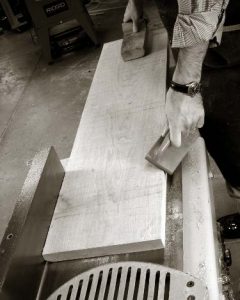
Here you can see the cathedrals, even in the rough. When jointing one face and the bark side is on the table, the cathedrals usually should point to the cutterhead.
Here are some supplies and tools we find essential in our everyday work around the shop. We may receive a commission from sales referred by our links; however, we have carefully selected these products for their usefulness and quality.




